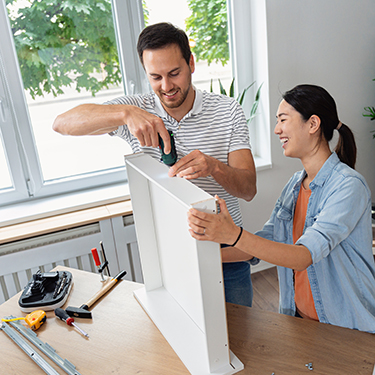The Joys and Woes of the Homeowner
 Once you’ve saved up for a down payment and feel ready to own your first home, there are expenses to consider that may determine how much home you can afford. Learn more about the expenses that can be fun, surprising, and sometimes alarming.
Once you’ve saved up for a down payment and feel ready to own your first home, there are expenses to consider that may determine how much home you can afford. Learn more about the expenses that can be fun, surprising, and sometimes alarming.
Decorating, Renovations and Upgrades
Moving into your new home is an exciting time, but it is costly. You’ll most likely need to purchase furniture and other decorations. Even if your home is new, you’ll want to personalize it with the paint colors of your choice. If your home is older, you may want to renovate the kitchen or bathrooms. These expenses are part of the joys of homeownership, and it’s easy to get carried away with spending when you first move in. Instead, plan and budget carefully so that you’re not breaking the bank to make your home your own.
If you bought an older home, upgrading the appliances or the heating, ventilation, and air conditioning (HVAC) system can save money on utilities. Newer energy-efficient appliances will have the Energy Star label, which could save you money on your electric bill. You may also claim a tax credit or rebate by upgrading appliances or making other energy-efficient home improvements. Review the list of eligible appliances and more at energy.gov.
With the advances of smart home technology, installing these upgrades improves security and convenience. Programmable thermometers and smart lighting are also more energy-efficient. Other expenses to consider include your outdoor spaces. Besides maintaining a lawn with a sprinkler system and lawn equipment, other expenses include outdoor seating, water features, and more. Although some of these expenses are routine, you can plan others to fit your budget.
Maintenance and Repairs
As your house ages, routine maintenance and repairs are necessary expenses. These are unavoidable, so plan accordingly by setting money aside in a savings account for home repairs. Severe storm damage from hail or high winds means you’ll need to budget for repairs, possibly a new roof, windows, or more. If your home is not new, it’s a good idea to have a home inspection every three to five years to make sure your home isn’t suffering damage you can’t see, like termites or mold. You should inspect homes that are 10 years old or older every two years.
Additional Expenses
Besides the unpredictable expenses, homeowners must budget for recurring costs. These include utilities, insurance, property taxes, and possibly homeowner’s association fees. Learn more about these additional expenses in our article 4 Expenses Added to Your Mortgage.
Texell Home Loans Can Help
If you have questions about buying a home, Texell’s Home Loan Heroes are ready to help. Our team of mortgage experts will walk you through the process. Call 254.779.5104 or visit TexellHomeLoans.com to get started.







